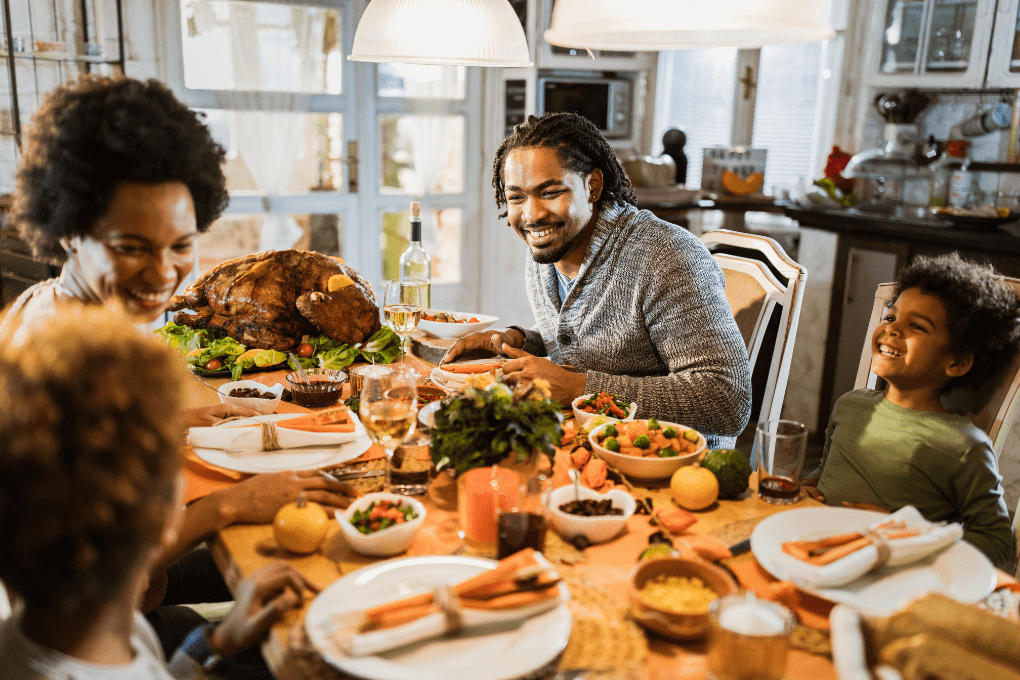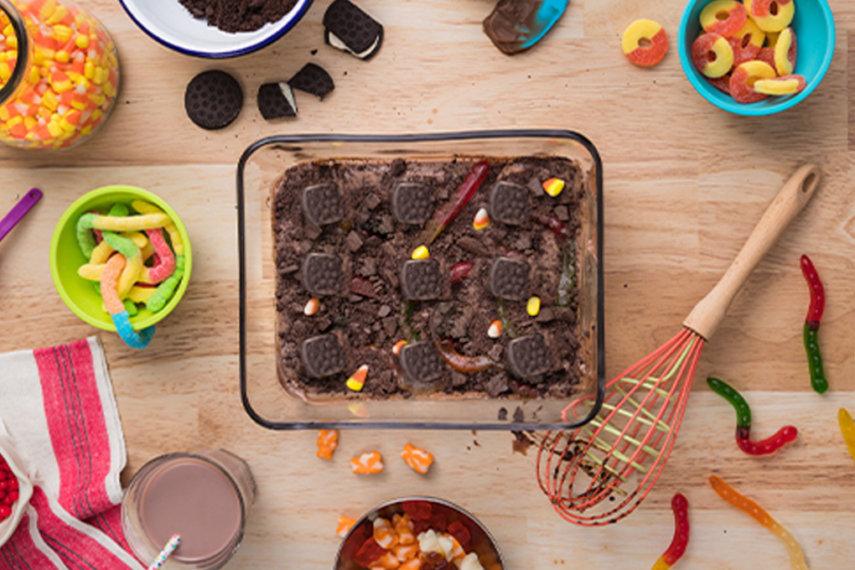
*Quotes used with permission; name changed to protect privacy.
“I just had the best Christmas of my adult life, thanks in large part to you.”
I was sitting in my cozy office sipping coffee and delving into comments from my client’s digital food journal as the frost glistened on the trees outside. Post-holiday food reflections are always a mixed bag, but typically they’re a stew of guilt, shame and regret topped off with a dollop of resolve to “get back on track.” Not this time.
“I did exactly what I said I would do and simplified my cooking and baking—and guess what, we had PLENTY! Even on the big family shopping day, I was able to notice my body fading around lunchtime and I listened. I simply told everyone, ‘I’m hungry for lunch, would anyone like to eat?’ and it was magic! I felt calm and centered just like I’d practiced at home and felt good about my choices. I never would have approached it this way if not for our talks, so THANK YOU!”
Like many of my clients, this person (I’ll call them AB) had experienced typical holiday angst around food and health: a packed schedule with social and family obligations revolving around food coupled with insufficient sleep. Add the stress of the holiday hustle and it’s no surprise they felt out of control, stuck in a cycle of restriction and disinhibition around food.
AB came to me a couple months earlier seeking stability. AB wavered between being “good” by planning meals and snacks daily, to completely “ruining everything” by letting their schedule—and their ravenous hunger—get the best of them.
I offered a new approach to AB: Intuitive Eating. While the term Intuitive Eating (IE) was coined in 1995 by registered dietitians Evelyn Tribole and Elyse Resch, the concept has been around since the 1970s (1). While the standard approach to dieting focuses on external measures of success (portion sizes, calorie and macro counts and weight loss), IE emphasizes body feedback and establishment of a sustainable, comfortable relationship with food. This radical shift in thought around food has been shown to improve psychological health as well as physical health markers such as blood pressure and cholesterol (2).
It’s no wonder that we struggle to connect with our intrinsic cues to guide our eating habits. The media constantly cajoles us into dieting through food rules, purported toxins, thin ideals, fear-based messages and outright food morality.
As I sat reading AB’s powerful reflections, I marveled at how each of the ten key principles of the IE framework were clearly at work. If you want to discover the same food freedom as AB during your holiday season, consider this brief introduction to IE. I highly recommend further reading or working with an IE-informed dietitian to fully grasp these concepts.
1. Reject The Diet Mentality
You are invited to release the feeling of failure instilled by the diet industry. Sounds exciting and a bit scary, right? That’s because many of us have been seeking permission to drop this external measure of “enoughness” for so long, but it’s all we’ve ever known. What are we supposed to do instead? (Hint: keep reading to find out!)
Some people are able to immediately bid good riddance to diet rules. Those who embrace this challenge are only too happy to discard diet books, unfollow harmful socials and donate their bathroom scales. This is the only type of “cleanse” I will ever endorse.
Others, however, might struggle with rejecting diet mentality. Some estimates indicate as much as 70% of women and over a third of men have engaged in weight cycling in their lifetimes (3,4).
To those skeptics who are afraid to abandon the comfort of diet mentality, I propose this: you can always return to it if IE doesn’t work for you. Diet culture (sadly) isn’t going anywhere, so you will always have that option. Giving yourself an intentional break from diet mentality could reveal a refreshingly liberating approach to how you engage with food and your body. What do you have to lose?
2. Honor Your Hunger
We are all born with an innate regulatory system to govern food intake. As we grow into children and adults, this system is blasted with all kinds of interference. Maybe we’re told specific times to eat (I see you, Intermittent Fasting). Or maybe the sensory and social influences surrounding a food scene muddle our ability to tune into our body cues. Some people disregard their body’s needs for so long they literally can’t tell when they’re hungry or satiated.
A large focus of IE involves reacquainting oneself with innate hunger and satiety signals. Research supports this approach, indicating that dietary quality and food enjoyment both improve when paying attention to our physical body cues (5,6).
Whether you consciously ignore hunger in an attempt to avoid holiday weight gain, or you are having too much fun skiing to stop for a bite to eat, denying your body food when it needs it is both ineffective and unkind. Excessive hunger usually drives people to overeat when food becomes accessible, which further precipitates distrust around food. Plus, when the body detects that it is in a famine (your cells don’t know that you’re intentionally restricting food—they just know they’re starving!), the body responds by increasing appetite and decreasing energy output. This further negates the efforts to lose weight because your wise body is doing everything it can to survive.
3. Make Peace With Food
Years of diet mentality create a secret war with food. Food is the enemy, something that is “sinful” or “naughty” or causes us to “be bad.” Many a lifelong dieter has gone years adhering to a list of forbidden foods. Particularly around the holidays, we’re pitched the narrative of indulging now because come the New Year it’s time to buckle down and “be good.” In fact, A 2021 survey found that 64% of Americans delay health attempts until after January 1st (7). This shift in health behaviors is reflected in the uptick of cardiovascular events during the holidays.
It is time to make peace with food once and for all. We must eat to live. And you earn food simply by being alive.
4. Challenge The Food Police
We live in a world where food fears are spewed like fireworks on the 4th of July. Social media influencers are imploring you to stop poisoning your body. Health gurus promise food secrets that guarantee disease-free longevity.
Look, as a registered dietitian I’m 100% behind you being well-nourished. I love learning about how foods interplay with our lifestyles and environments. Nutrient/body interactions fascinate me. That said, the notion that eating a certain way definitely leads to ‘x’ health outcome is hogwash. There are no guarantees in health, and we actually have less influence over health risk and outcomes than we’d like to think. Social Determinants of Health (8) and genetic predisposition (9) are two such uncontrollable health factors.
This isn’t a free pass to simply ignore the many benefits of good nutrition. My point is that the diet industry places way too much emphasis on the minutiae of food benefits and detriments, resulting in fear and confusion for the masses. Stop trying to eat perfectly for the sake of preserving your health or gaining a sense of morality. You are not good/bad for eating a certain food. Eating patterns are not morally driven.
A first step toward challenging the food police is to pay attention to judgmental words you think or say regarding food and your body. Common culprits are “should” or “shouldn’t,” and “cheat” or “bad.” Try using more neutral language that describes the food. For example, if you always refer to ordering pizza as a “bad” move, consider telling yourself, “Pizza is one of my favorite foods, and I just love the melty cheese.” This dovetails nicely into the satisfaction factor (see Principle 6).
5. Feel Your Fullness
Picture this: you’re enjoying a holiday meal with family and your plate is filled with all of your favorites. Amazing smells of mouth-watering, special dishes surround you, and there is not a single free space on your perfectly curated plate. It’s time to dig in!
As you begin eating, the flavors are intense and wonderful. Perhaps you like to mix certain foods to make the perfect, complementary bite. Or maybe you work your way around the plate, saving the best for last. Your senses are alive with all the wonderful tastes, aromas and textures as you continue to enjoy your meal.
Now pause and imagine you suddenly feel very full. Uncomfortable, even. But there are still several bites of your favorites left to eat. What do you do?
If you’re like many dieters, you power through a few more bites or even clean your plate. We can’t waste food, especially not rare, holiday treats! Even if eating those last few potatoes takes great effort, you remind yourself that this event only comes around once in a while so you can get the job done.
This scenario I’ve just painted is remarkably common when it comes to holiday eating. There are two specific principles to consider here: making peace with food (which we covered above) and disregarding your fullness.
People who have restricted calories for years will often struggle to feel their fullness with confidence (10). They’ll eat only the minimum amount to make hunger pangs stop, then get filled with anxiety when the body naturally asks for food an hour later. Some people come from a “clean plate club” where they’ve been conditioned to eat only at specific times and to eat all that is available at those times. Disregarding fullness cues can also come from a history of food insecurity.
Just like the hunger cues I mentioned above, your fullness cues are alive and well even if they’ve been disregarded or ignored altogether due to pesky dieting approaches. Here are some ways to reacquaint yourself with your body’s biological fullness:
- Slow the pace of your meal. Put your utensils down between bites. This is not a race.
- Pause during a meal and become aware of how your body feels compared to when you started eating. Notice anything?
- If you’re prone to cleaning your plate, portion out a smaller amount and start with that. Then observe how your body feels. You can always honor your hunger if you feel like you need more to eat.
- Know that there are different levels of physical fullness. Get to know how they feel to you. A sample hunger/satiety scale, readily found online, can help get you started.
6. Discover The Satisfaction Factor
Human nutrition is largely measured by the specific nutrients consumed in the diet. Calories, macros, vitamins and minerals…food tends to be reduced to these molecules, and people want to know the exact “right” way to eat.
In reality, the right eating pattern is one that is sustainable, affordable, accessible, reflects your cultural and religious beliefs, and *gasp* tastes good! Yep, you heard it here, folks: food should be enjoyable.
I’m not just talking about the special foods that appear during the holiday season. You should enjoy the foods you eat most of the days of your life. There will inevitably be favorites, and that’s a-okay. But let’s not try to convince ourselves that ground-up cauliflower provides the same eating experience as rice, or that sugar-free ice cream hits the same as full fat ice cream.
I’m not poking fun at anyone who enjoys riced cauliflower or sugar-free ice cream, by the way. But the diet industry works hard to convince us that health-approved food imposters taste just as good as their traditional counterparts…and that leads to feelings of deprivation and longing.
7. Cope With Emotions Without Using Food
Between family gatherings, work deadlines, loneliness and financial stress, holiday time can carry a wide variety of emotions. Food might be the constant companion through it all.
This was a huge factor in AB’s experience. At the core of their holiday food struggles was the emotional drive to eat…or not. Throughout our work, AB recalled stressful situations with family and friends that led them to disregard the principles of IE. Stress at work might lead to skipped meals and even celebrating daily restriction. Then social gatherings led to a mentality of “I’ve earned this due to [a hard day at work, not eating much all week, being “good” today],” and suddenly food became a reward. Furthermore, AB’s poor body image led to feelings of shame and guilt upon eating certain foods, which resulted in further restriction/disinhibition cycles.
Food is one way, and an effective short-term way, to cope with emotions. I say “effective” here because the brain releases feel-good neurotransmitters in response to being fed. Imagine that! However, this effect is temporary, and doesn’t actually address the underlying emotion. Most people who consistently use food to cope with emotions lack both emotional self-awareness and the skills to cope with those emotions.
Building self-awareness around emotions and developing the vocabulary to describe them can be challenging. I recommend working with a counselor or therapist to build these skills and commit to practicing them.
8. Respect Your Body
At the core of diet culture is the ongoing message that your body is wrong and needs changing. The diet industry is largely predicated on insisting that it is better to be a smaller sized person, regardless of the psychological and emotional trade-offs.
This is not only damaging but incredibly unrealistic. While the average women’s clothing size sits around size 16-18, many retailers still consider size 16 to be a plus size which can only be found in specialty stores or ordered online (11).
We all have a unique set of genetics, history, health metrics, environmental factors, economic considerations and personal circumstances that add up to our body size. How you eat is one (relatively small) piece of the puzzle. Consistently pursuing a body size that is not naturally yours is not only harmful but leads to a pretty bleak self-image.
Think of it this way: you wouldn’t force your size 8 foot into a size 6 shoe. The body you have deserves to be nourished and nurtured. The body you have is a gift. Respect it.
With the constant hustle of the holidays, it is important to really zero in on this one. In what ways can you show your body care and respect? What behaviors do you tend to engage in during the holidays that leave your body feeling wrung out and exhausted? What movements, foods, interactions and activities help your body feel best? Are you thinking of your body as an ornament or an instrument?
9. Exercise- Feel The Difference
One of the biggest things I hear throughout the winter months is that people press pause on exercise for a few weeks, and then feel compelled to sign up for the latest New Year’s challenge at their local gym. Going from minimal physical activity to a frenetic workout routine is not health protective. It is also unsustainable, as evidenced by a dismal 9% success rate of New Year’s Resolutions (12).
This holiday season, I invite you to rethink how and why you’re moving your body. Maybe it means setting boundaries around your schedule so you can continue attending the evening spin class you love so much. Or maybe those dusty snowshoes in your garage need to be shown some daylight. And yes, walking laps at the shopping mall counts, too! For a double-duty activity, consider taking up yoga a couple days a week. Not only is this purposeful movement, but you’ll get emotional and psychological benefits as well.
However you choose to move, do not use exercise punitively or a justification to eat. You earn the right to eat by being alive. Period.
10. Honor Your Health Through Gentle Nutrition
And finally, we’re at the principle where everyone in diet culture wants you to start: nutrition. So many people come to me asking, “What should I eat?” I respond by suggesting we first address the why and how of the eating before the what.
Remember, food has some influence over our health, but so do many other factors. Tribole and Resch wisely used the word “gentle” to qualify the attention on nutrition because it is often over-exaggerated.
Here’s an example: a person reports that their lunch consisted of a turkey sandwich on a piece of French baguette with mayo, cheese, lettuce and tomato + chips and 12 oz of sweet tea. Looking at this meal, the food police would have sirens blaring and lights flashing. WHITE BREAD!! PROCESSED FOOD!! SWEET DRINKS!! Diet culture would chastise this meal, pick it apart for not being nutritious enough and provide all kinds of righteous corrections to make it “healthy.”
Now, let’s give a bit more context. This individual is prone to skipping lunch altogether, or simply diving into the bag of chips stowed in their desk drawer. This leads to excessive hunger, mood swings and subsequent bingeing (usually on high-carb foods from their pantry) when they get home. They used to drink sweet tea throughout the day and now only enjoy it with their lunch. It’s also been found that they consume inadequate protein throughout the day and rarely include vegetables in their eating pattern because they’re hard to access for this person. Oh, and this person works 70 hours a week with two jobs, a busy family and minimal financial resources.
All the sudden this lunch looks much more like gentle nutrition for this individual. When we add self-compassion to our health quests, the trajectory takes us toward progress, not perfection. We all have a set of circumstances that impact our food choice, availability and flavor preferences.
You have enough going on in your life that scrutinizing your every bite for the “right” nutrition is not an effective use of your time or your gifts to this world.
If you’re tired of the same yearly cycle that has you tumbling through the holidays only to come out the other side in a regretful, depressed and exhausted heap, here’s your nudge to consider the Intuitive Eating approach. Chances are, at least one of these ten principles resonates with your experience and has you curious enough to try a different approach. Who knows? It could result in a similar sentiment to AB’s, reflecting on the best holiday season of your adult life.
References:
1. Sparks A. Intuitive eating: Principles, definition, benefits, and more. Medical News Today. August 23, 2021. Accessed October 24, 2023. https://www.medicalnewstoday.com/articles/intuitive-eating.
2. Van Dyke N, Drinkwater EJ. Review article relationships between Intuitive Eating and Health Indicators: Literature Review. Public Health Nutrition. 2013;17(8):1757-1766. doi:10.1017/s1368980013002139
3. Aggarwal B. Yo-Yo dieting linked to heart disease risk in women. Columbia University Irving Medical Center. March 7, 2019. Accessed October 24, 2023. https://www.cuimc.columbia.edu/news/yo-yo-dieting-linked-heart-disease-risk-women.
4. Stevens VL, Jacobs EJ, Sun J, et al. Weight cycling and mortality in a large prospective US study. American Journal of Epidemiology. 2012;175(8):785-792. doi:10.1093/aje/kwr378
5. Camilleri GM, Méjean C, Bellisle F, et al. Intuitive eating dimensions were differently associated with food intake in the general population–based NutriNet-Santé study. The Journal of Nutrition. 2017;147(1):61-69. doi:10.3945/jn.116.234088
6. Christoph MJ, Hazzard VM, Järvelä-Reijonen E, Hooper L, Larson N, Neumark-Sztainer D. Intuitive eating is associated with higher fruit and vegetable intake among adults. Journal of Nutrition Education and Behavior. 2021;53(3):240-245. doi:10.1016/j.jneb.2020.11.015
7. Holiday habits survey reveals 64% of Americans push healthy “new year, New me” to after the holidays. PR Newswire: press release distribution, targeting, monitoring and marketing. December 9, 2021. Accessed October 24, 2023. https://www.prnewswire.com/news-releases/holiday-habits-survey-reveals-64-of-americans-push-healthy-new-year-new-me-to-after-the-holidays-301441220.html.
8. Social Determinants of health literature summaries. Social Determinants of Health Literature Summaries – Healthy People 2030. Accessed October 26, 2023. https://health.gov/healthypeople/priority-areas/social-determinants-health/literature-summaries.
9. Wehby GL, Domingue BW, Wolinsky FD. Genetic risks for chronic conditions: Implications for long-term wellbeing. The Journals of Gerontology: Series A. 2017;73(4):477-483. doi:10.1093/gerona/glx154
10. Bilman E, van Kleef E, van Trijp H. External cues challenging the internal appetite control system—overview and practical implications. Critical Reviews in Food Science and Nutrition. 2015;57(13):2825-2834. doi:10.1080/10408398.2015.1073140
11. Christel DA, Dunn SC. Average American women’s clothing size: Comparing National Health and Nutritional Examination Surveys (1988–2010) to ASTM International Misses & Women’s Plus Size Clothing. International Journal of Fashion Design, Technology and Education. 2016;10(2):129-136. doi:10.1080/17543266.2016.1214291
12. Thinking of changing your behavior in 2017? try moving first (2017) SPSP. Available at: https://spsp.org/news-center/press-release/thinking-changing-your-behavior-2017-try-moving-first (Accessed: 28 October 2023).
13. Tribole, E. and Resch, E. (2012) Intuitive eating: A revolutionary program that works. New York: St. Martin’s Griffin.



